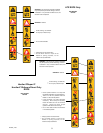
601656_1108
temperature. If the coolant reaches an unsafe level during operation,
shut down the machine as soon as possible. Never risk continued
operation when the gauge needle is in the high range; high
temperatures can severely damage the engine.
Never risk continued operation when light remains on: high
temperatures can severely damage the engine.
An audible alarm will sound when the engine coolant is close to
overheating.
I. Alternator warning light (Fig. 3-1) — this light comes on when
the ignition switch is placed in the RUN position and stays lit until
the engine is running and the battery is being charged. If light
comes on during operation, shut engine off immediately, locate and
correct the problem.
If light remains on while engine is running, it indicates that the
battery is being discharged.
J. Electronic hour meter (Fig. 3-1 & 3-6) — registers 1/10 hour
increments up to 9,999.9 total hours. Connected to the ignition
switch, the meter records the accumulative time while the ignition
key is switched to the RUN position. NOTE: The hour meter is
found in various locations on different tractors.
K. Glo-plug light (Fig. 3-1) — this light comes on when the ignition
switch is turned to the “Pre-Heat/Run” position and held. It shows
that power is going to the glo-plugs.
L. Fuel tank gauge (Fig. 3-1) — This gauge shows the fuel level for
each fuel tank. The red light indicates that the fuel tank is empty
and the operator needs to re-fuel immediately. The upper gauge
indicates the fuel level in the right fuel tank and the lower gauge
indicates the fuel level in the left fuel tank.
Controls
A. Control levers (Fig. 3-3 & 3-4) — these levers control the tractor’s
speed, direction, stopping, and park brake. Levers are used to steer,
accelerate, decelerate and change direction. When the control levers
are in the park brake position (3-3) the tractor will not move when
the engine is on and drive pumps are operating.
WARNING: The parking brake may not hold the tractor if
parked on a slope. Block or chock the machine when parked
on a slope.
B. Deck lift pedal (Fig. 3-5) — the deck lift pedal is used to raise or
lower the deck. Push on the pedal to raise the deck and then place
the deck height locking pin into the desired cutting height hole.
Push the deck lift pedal to raise the deck when going over
obstructions.
Figure 3-4
Control lever in park
brake position
Figure 3-3
Control
lever
Shown with control levers
in neutral position
Figure 3-5
Deck lift
pedal
Figure 3-6
Hour
meter
16
Figure 3-2
Throttle


















